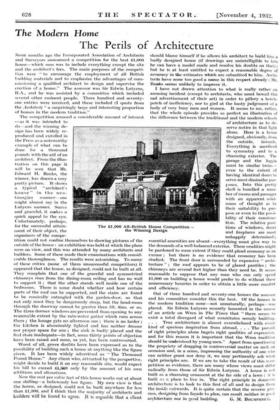The Modern Home
The Perils of Architecture
SOME months ago the Incorporated Association of Architects and Surveyors announced a competition for the best 11,000 house—which sum was to include everything except the site and the architect's fees. The main purposes of the competi- tion were "to encourage the .employment of all British building materials and to emphasize the advantages of com- missioning a qualified architect to design and supervise the erection of a house." The assessor was Sir Edwin Lutyens, ILA., and he was assisted by a committee which included several other eminent people. Three hundred and seventy- one entries were received, and these included (I quote from the Architect)" a surprisingly large and interesting proportion of houses in the modern tradition."
Worst of all, grave doubts have been expressed as to the possibility of building such a house at anything like the figure given. It has been widely advertised as "The Thousand Pound House." Any client who, attracted by the perspective, might decide to build it on any reasonable site, would expect his bill to exceed £1,000 only by the amount of his own additions and alterations.
Now the cost per cubic feet of this house works out at about one shilling—a ludicrously low figure. My own View is that the house, as designed, could not be built anywhere for less than /1,300, and I think that the Majority of architects and builders will be found to agree. It is arguable that a client. The £1,000 Ali-British House Competition— the Winning Design should blame himself if he allows his architect. to build him a badly designed house (if drawings are unintelligible to hint he can have a model made and resolve his doubts on that); but he is at least entitled to expect a reasonable degree of accuracy in the estimates which are submitted to him. Archi- tects have none too goods name in this respect already : Mr. Banks seems unlikely to improve it.
Out of three hundred and seventy-one houses the assessor and his committee consider"this the best. Of the houses in the modern tradition none—not unnaturally, perhaps—was placed. Sir Edwin Lutyens recently lamented in the course of an article on Wren in The Times that "there seems to exist a total disregard of what constitutes seemly building. . . . True architecture is almost overwhelmed with every kind of specious inspiration from abroad, . . . The pursuit of right principles alone begets right qualities of expression, and for this reason it is important that the Wren tradition should be understood by young men." Apart from questioning the propriety of dragging in controversial matter on such an occasion and, in a sense, impressing the authority of one who can neither grant nor deny it, we may pertinently ask what right principles are. If we are to take the result of this com- petition as evidence, there are many whose views must differ radically from those of Sir Edwin Lutyens. A house is not built as a charming ornament at the far side of a lawn : it is built as a place to live in. The right principle in domestic architecture is to look to this first of all and to design from the inside outwards. It is quite certain that the reverse pro- cess, designing from façade to plan, can result neither in gocd architecture nor in good building. .G. M. BoumrtutEY.










































 Previous page
Previous page